22+ Best Grim Reaper Movies
When used as a character in a movie, the Grim Reaper allows filmmakers to explore human mortality and the meaning of life. Featured here are the greatest uses of the personification of Death in film.
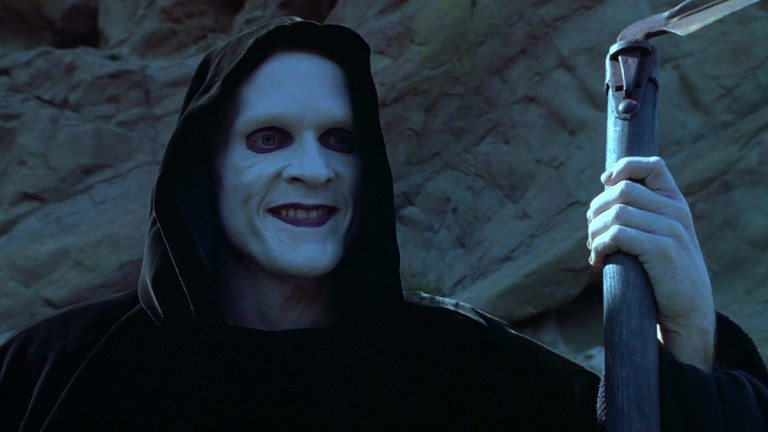
Death is inevitable. Since dying is a natural part of life, people throughout history have personified Death in various ways. The most recognizable form of Death in Western culture is that of the Grim Reaper.
The image of the Grim Reaper as a skeletal figure wearing a black, hooded robe and carrying a scythe is thought to originate in Europe during the 1300s. With the Black Death killing millions of people in the 14th century, the idea of a soul-harvesting figure creeped into everyone’s minds. The image of a scythe-wielding skeleton stuck. Much later, the name “Grim Reaper” was first used in association with the personification of Death in the book The Circle of Human Life (1847).
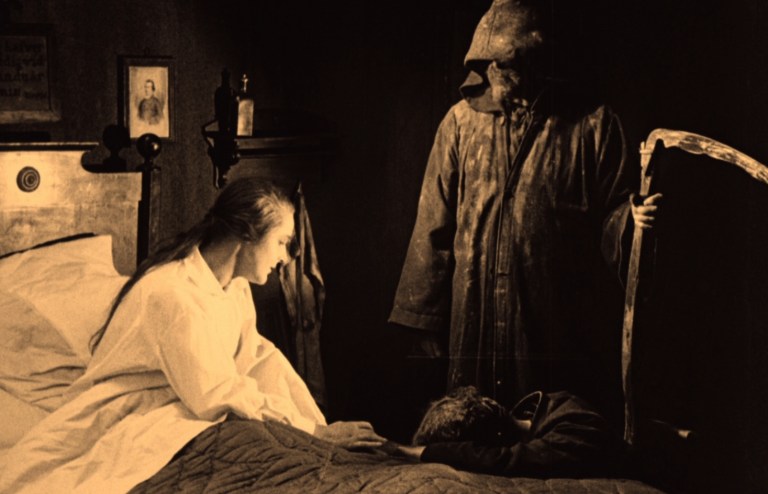
Death as a character in movies goes back to the silent era with early portrayals seen in films like Eerie Tales (1919). However, The Phantom Carriage (1921) may be the earliest reaper-like appearance of Death, complete with a dark robe and scythe. Since then, the Grim Reaper has appeared in movies in various forms, some more human than others.
As a character and an archetype in film, the Grim Reaper is used in far fewer films than more popular supernatural entities like vampires and witches. Perhaps it’s the Reaper’s traditionally grim demeanor that keeps him (or her) out of the spotlight. Or perhaps it’s because audiences aren’t terribly eager to be directly confronted with their own mortality. Either way, this list chronicles the most notable depictions of the Grim Reaper in movies along with a few interesting variations.
Movies About the Grim Reaper
The Phantom Carriage (1921)

The Phantom Carriage is one of the earliest depictions on film of a scythe-carrying representation of Death. The movie follows David (Victor Sjöström), a drunkard and unrepentant jerk who has a near-death experience after being hit on the head with a bottle. As David’s soul leaves his body, he is visited by a ghostly man in a carriage who attempts to help David see the harm his actions in life had on others. The spirit that visits David is his friend Georges (Tore Svennberg) who died a year prior, so he is technically a grim reaper and not the Grim Reaper. However, the robe Georges wears and the scythe he carries are clear indications of who and what he represents.
Metropolis (1927)
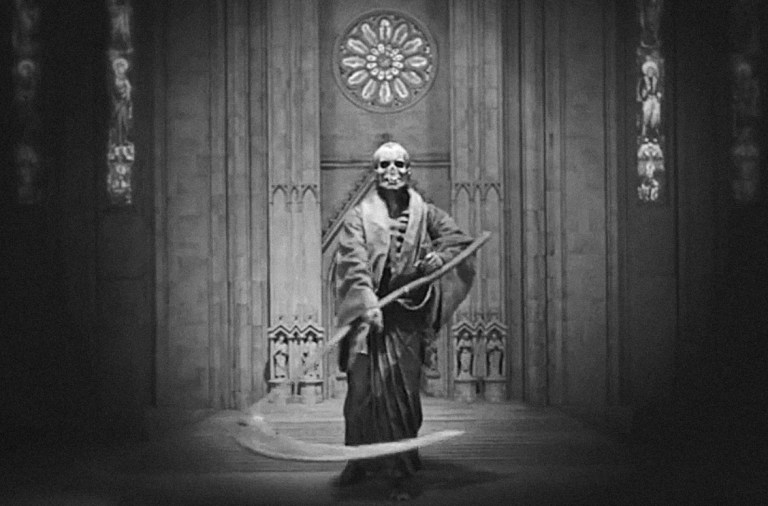
Metropolis, the 1927 German masterpiece by Fritz Lang, features the Grim Reaper briefly in a pair of highly memorable scenes. First, Freder (Gustav Fröhlich), the heart of the movie, sees a statue of Death centered among other statues representing the seven deadly sins. Freder is unnerved, and he later hallucinates that the statue of the Grim Reaper comes to life, playing a bone as a flute and swinging its scythe. Though it’s difficult to confirm definitively, the opening credits indicate that Death is played by Brigitte Helm who also famously plays Maria and the Maschinenmensch (aka Machine Man) in the film.
Death Takes a Holiday (1934)
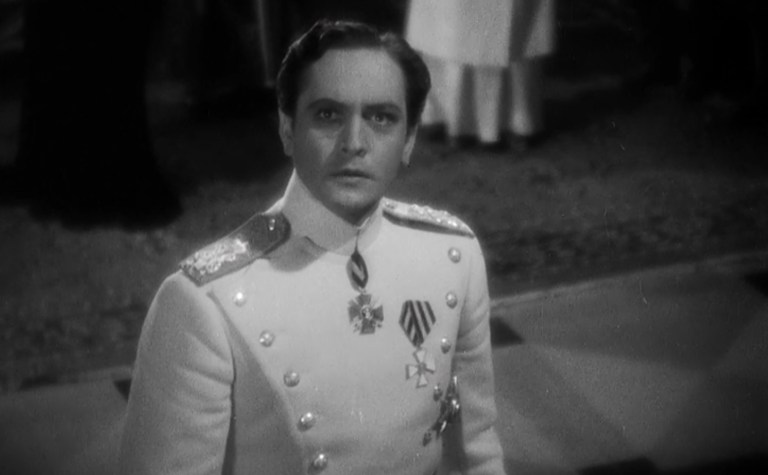
Directed by Mitchell Leisen, Death Takes a Holiday stars Fredric March as Death in human form. Death takes a break from his duties for a few days so he can mingle among humans to try to understand why people fear him. Death takes the form of a handsome Prince, and he begins to experience human emotions for the first time when he falls for the beautiful Grazia (Evelyn Venable). Part romantic comedy and part contemplative drama, Death Takes a Holiday is a classic.
On Borrowed Time (1939)
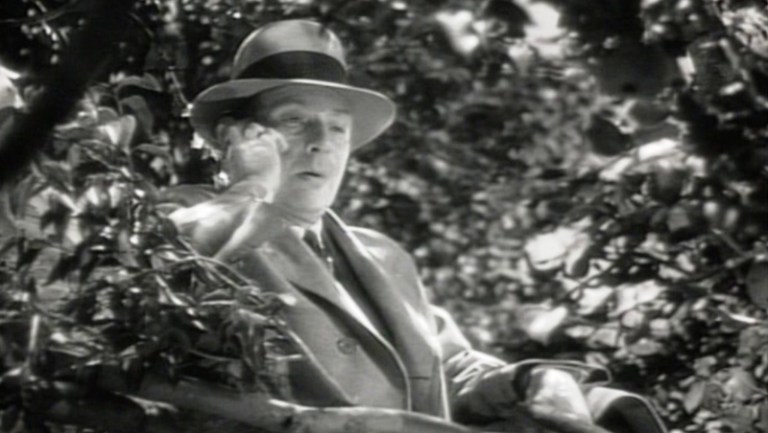
A cantankerous old man traps the Grim Reaper in an apple tree in the touching family drama On Borrowed Time. The old man, known as Gramps (Lionel Barrymore), isn’t ready to head into the afterlife because he is worried about leaving his orphaned grandson Pud (Bobs Watson). When Death comes for Gramps in the form of Mr. Brink (Cedric Hardwicke), Gramps uses a wish he was granted to trick Mr. Brink into remaining stuck up a tree until Gramps decides to let him down. With Death unable to do his job, no one in the world, including Gramps, will die, but Gramps will learn that there is a reason death is an unavoidable part of life.
The Seventh Seal (1957)

Ingmar Bergman’s The Seventh Seal contains what is easily one of the most iconic portrayals of Death ever put on film. The story is about a knight named Antonius Block (Max von Sydow) who finds that Death (Bengt Ekerot) has been following him after returning from The Crusades. Block and Death engage in a game of chess which allows Block to stay in the world of the living for as long as he can avoid checkmate. The Seventh Seal is a beautifully crafted existential experience that explores the desire to live a life of meaning when literally coming face to face with Death.
The Masque of the Red Death (1964)
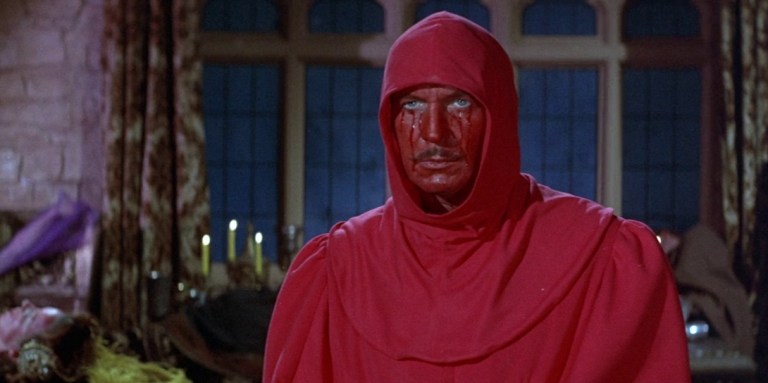
Though Vincent Price may may not play the version of the Grim Reaper most people are accustomed to, the red-robed figure in Roger Corman’s The Masque of the Red Death is unquestionably a personification of Death. The story is derived from Edgar Allen Poe‘s tale about the arrogant and unfeeling Prince Prospero (also played by Vincent Price) who throws a party for the upper class while the poor villagers outside die from a horrifying plague. The movie is surprisingly bright and colorful for such dark material, but that’s part of its undeniable charm.
Love and Death (1975)

Woody Allen plays a pacifist forced to join the Russian army when Napoleon invades Austria in the satirical comedy Love and Death. Diane Keaton costars as Sonja who ends up marrying Allen’s character Boris not because she wants to, but because she’s being nice and thinks he’ll die soon in a duel anyway. Not to spoil the movie too much, but Death does eventually come for Boris in the guise of a white-robed Grim Reaper. Death’s appearance is brief, but it fulfills the second half of the movie’s title in a deadpan way that is completely true to Allen’s comedy style.
Monty Python’s The Meaning of Life (1983)
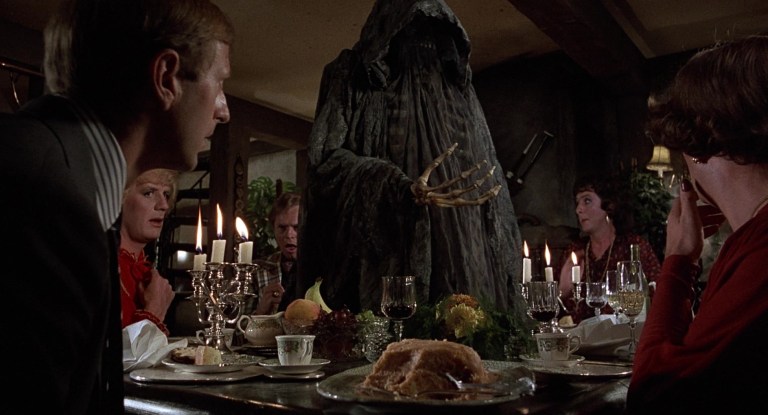
In the segment titled “Death” in Monty Python’s sketch-comedy film The Meaning of Life, the Grim Reaper visits a group of people having a dinner party. The Reaper tries to explain that they must all go with him, but they have a hard time understanding what he is trying to tell them. Hilarity ensues. This version of the Grim Reaper is especially haunting, with his large stature, deep voice, skeletal hands, and face hidden in shadow. His ominous appearance makes it even funnier when he starts to get annoyed with everyone.
The Adventures of Baron Munchausen (1988)

In something of an ode to tall tales, The Adventures of Baron Munchausen is a fantasy adventure that chronicles the exploits of the titular baron as he goes on a series of fantastical adventures. Baron Munchausen (John Neville) is constantly a few steps ahead of the Angel of Death during his death-defying journeys where he encounters a colorful cast of characters played by stars such as Robin Williams, Eric Idle, Sarah Polley, Oliver Reed, and Uma Thurman. The Grim Reaper in this movie is one of the more intriguing designs found on film: Death is a skeleton in a flowing black robe, carrying a scythe, and propelled through the air by beautiful black wings.
Scrooged (1988)

Of all the live-action versions of Charles Dickens’ A Christmas Carol (1843), the Ghost of Christmas Future from Scrooged is easily one of the most interesting. The ghost, which is an incarnation of Death, approaches the caustic Frank Cross (Bill Murray) near the end of his revelatory journey and shows him the effects his life will have on others. Viewers briefly see the ghost’s skull face in a wall of television screens behind Frank, but when the ghost interacts with him, its face has changes to a TV screen that shows Frank a series of images depicting his true nature.
Ghost (1990)
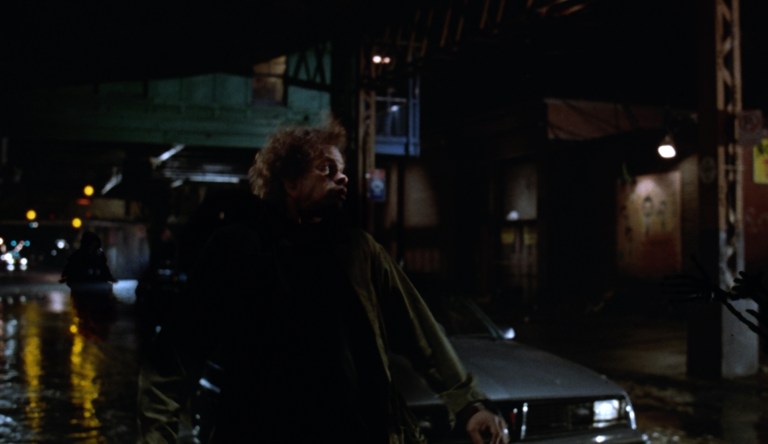
Ghost may be not immediately spring to mind for a list like this, but the movie exemplifies how the popular image of the Grim Reaper has shaped our perception of death in various forms. In this supernatural romance from director Jerry Zucker, Patrick Swayze plays Sam, a recently deceased man who tries to save the love of his life, Molly (Demi Moore), from the man ultimately responsible for his death. In the afterlife, Sam sees the ghosts of bad people dragged to Hell by a group of groaning figures that look like the shadows of skeletons in black robes. It only happens a couple of times in the film, but the speed at which the swarm of Reapers act is terrifying.
Bill & Ted’s Bogus Journey (1991)
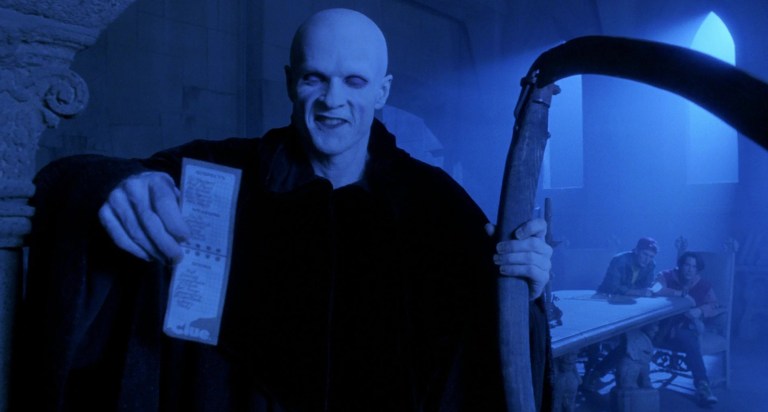
Many films have parodied Death from The Seventh Seal (1957) over the years, but no imitation is as memorable as William Sadler’s performance in Bill & Ted’s Bogus Journey. Death appears in typical fashion (pale skin, black robe, scythe) when Bill S. Preston, Esq. (Alex Winter) and Ted “Theodore” Logan (Keanu Reeves) are killed by their evil robot doppelgangers from the future. Confidently, Death offers to allow Bill and Ted a chance to play a game to save their souls. Bill and Ted then proceed to beat an increasingly frustrated Death in Battleship, Clue, electric football, and Twister. Defeated, Death joins the dimwitted duo in their quest to regain their lives, get back their princess girlfriends, and save the world with rock ‘n’ roll as the band Wyld Stallyns.
Last Action Hero (1993)
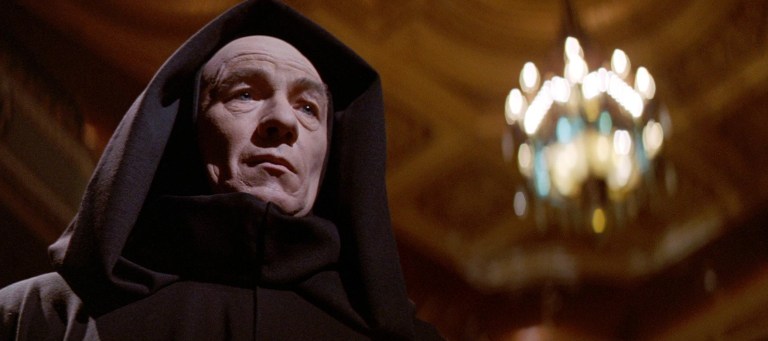
Last Action Hero takes place in a world where a magic ticket once owned by Harry Houdini allows young Danny (Austin O’Brien) to transport himself into a movie. After some adventures with action hero Jack Slater (Arnold Schwarzenegger), Danny and Slater are forced to save the real world from an invasion of movie villains. One of the villains that stalks Slater is Death who enters the real world from a screening of Ingmar Bergman’s The Seventh Seal (1957). Death is more helpful than he appears to be at first, and his actions set up a finale that seems to go against what Death usually stands for.
Cemetery Man (1994)

The story of Cemetery Man (aka Dellamorte Dellamore) follows cemetery caretaker Francesco Dellamorte (Rupert Everett). Francesco not only looks after the cemetery grounds, but he also re-kills the recently deceased who have a tendency to rise from their graves as zombies. After an obsessive love affair ends particularly badly for Franceso and a mysterious widow (Anna Falchi), the Grim Reaper appears in front of Francesco and offers a suggestion about a more efficient way to stop the dead from rising: kill the living with a bullet to the head. Whether or not this incarnation of Death is real or a figment of Francesco’s fractured mind is up for debate, but what is not debatable is how amazing this skeletal, winged version of the Grim Reaper looks while standing in fire.
The Frighteners (1996)
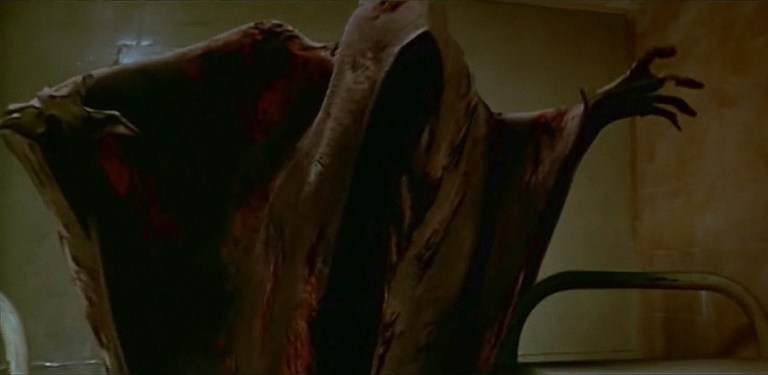
Without spoiling this fantastic movie, the Grim Reaper in The Frighteners may not be exactly what it seems at first. Frank Bannister (Michael J. Fox) is a man who gained the ability to see ghosts after a traumatic accident. Since Frank’s contacts in the spirit world give him information no living person should know, he becomes a suspect in a string of deaths perpetrated by an entity that looks like the Grim Reaper. Naturally, this puts Frank and the Reaper into a conflict that transcends life and death. Horror icons Dee Wallace and Jeffrey Combs are also featured in this wonderfully fun film.
Meet Joe Black (1998)

Brad Pitt plays a handsome Death in Meet Joe Black. In the movie, Death takes the form of an unnamed man Susan (Claire Forlani) meets in a coffee shop who is later killed when he is hit by two cars. Using the face of the dead man and taking the name Joe Black, Death befriends Bill (Anthony Hopkins), Susan’s father. Joe is intrigued by Susan, and as long as Bill serves as Joe’s guide on Earth, Bill won’t die of his impending heart attack. With the setup complete, Meet Joe Black plays out as a romantic drama that, even at nearly three hours, is beloved by its many fans.
Six-String Samurai (1998)
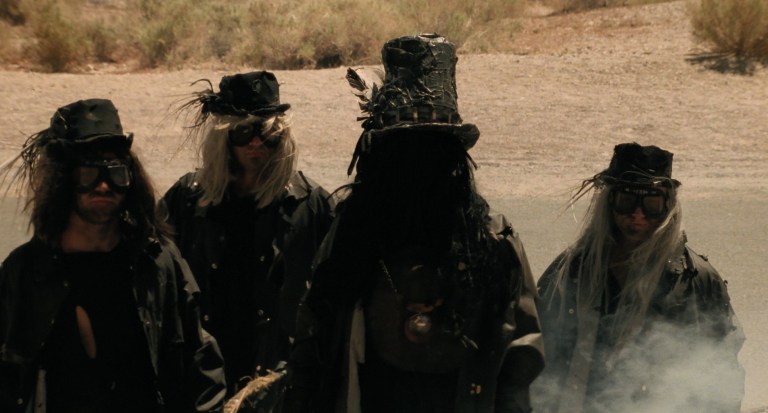
Death wields a guitar and sword in the quirky action-musical-comedy Six-String Samurai. In an alternate history where the Soviet Union bombed the United States into a post-apocalyptic wasteland in 1957, Elvis became the king of what was left. Forty years later, King Elvis is dead, and wandering swordsman/guitarist Buddy (Jeffrey Falcon) journeys to Lost Vegas to claim the throne of the King of Rock ‘n’ Roll. Death (Stephane Gauger) follows Buddy, intent on proving the dominance of heavy metal music by killing every contender for the throne. Six-String Samurai is a fun mashup of all sorts of genre films which may be too odd for some, but that’s also why it became a cult classic.
Final Destination (2000)
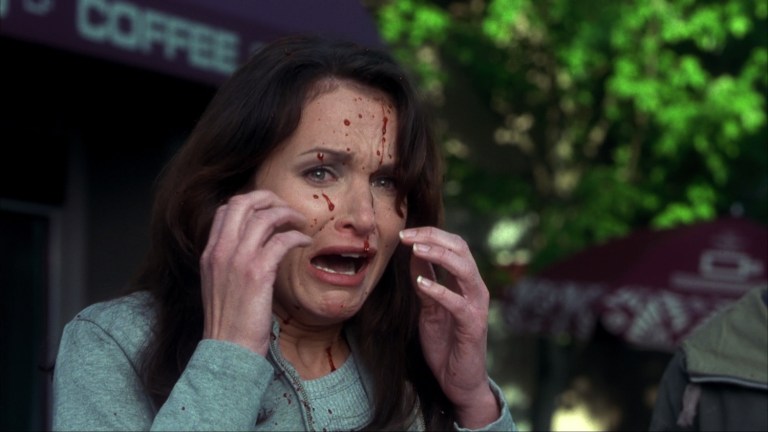
The Grim Reaper has many iconic looks in movies, but Final Destination chooses to give Death no look at all. Instead, Death is an invisible force that is felt through its actions as it takes a group of people one by one after they manage to avoid their originally scheduled deaths. Though the killings are made to look like accidents, the movie makes it clear that Death is an intelligent entity. Many of the “accidents” are so absurdly convoluted (in a good way) that they are more like deadly Rube Goldberg machines than anything that could be explained away as something natural.
Terry Pratchett’s Hogfather (2006)
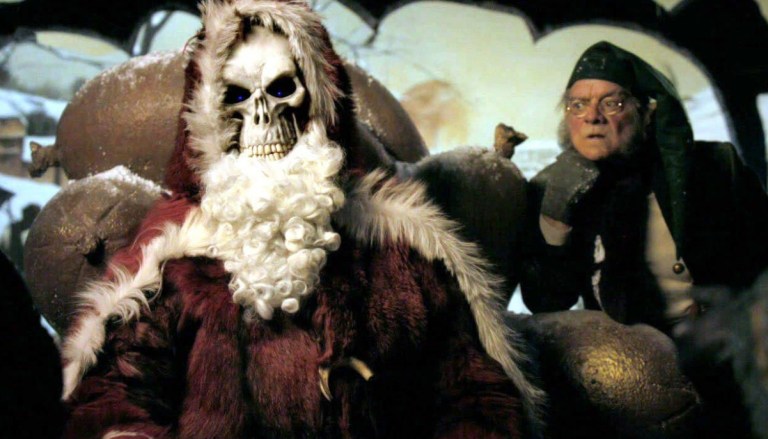
Though Hogfather is technically a television miniseries, it was also released on DVD as a single movie, so it warrants inclusion in this list. Besides, author Terry Pratchett’s version of the Grim Reaper is much too amazing to be left out. Hogfather is based on the 1997 novel of the same name by Pratchett, and it is about Death taking over for the Hogfather (a parody of Santa Claus) to fulfill his duties on Hogswatchnight (a parody of Christmas). While Death tries to get into the spirit of the season, his granddaughter, Susan, investigates the disappearance of the real Hogfather. Hogfather is a silly and touching movie perfect for the holiday season.
Hellboy II: The Golden Army (2008)

Guillermo del Toro is a director with an uncanny knack for envisioning some of the mostly darkly beautiful characters on film. For the Angel of Death (a close equivalent of the Grim Reaper), Guillermo del Toro drew upon an idea inspired by a painting he saw in a church in Mexico more than a decade prior. He sketched a design of an Angel of Death with eyes in its wings like the angels in the painting, intending to use it in a project that was never completed. For the Hellboy 2, Guillermo del Toro revisited the idea with some final polishing done by one of the key sculptors on the crew, Norman Cabrera.
Harry Potter and the Deathly Hallows: Part 1 (2010)
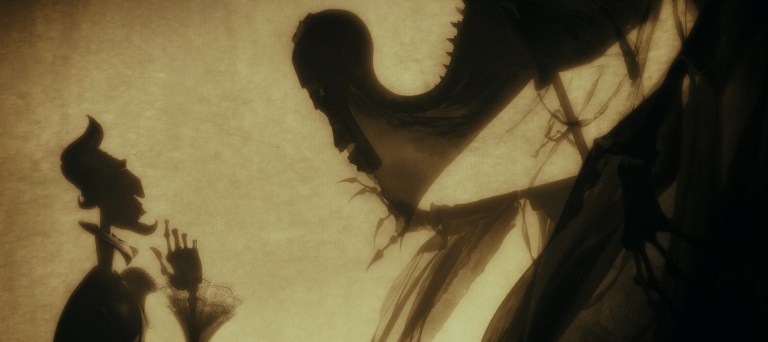
During the course of the penultimate movie in the Harry Potter film series, Harry (Daniel Radcliffe), Hermione (Emma Watson), and Ron (Rupert Grint) learn about the origin of a trio of magical objects known collectively as the Deathly Hallows. When all three objects (the Elder Wand, the Resurrection Stone, and the Cloak of Invisibility) are used by a single person, they give that person complete mastery over Death. In the origin story of the Deathly Hallows, illustrated in the movie in an animated sequence, Death is depicted as a giant skeletal creature with a flowing cloak and giant wings. It’s too bad we never see this version of Death in live-action, but the mystery adds to the intrigue.
The Book of Life (2014)
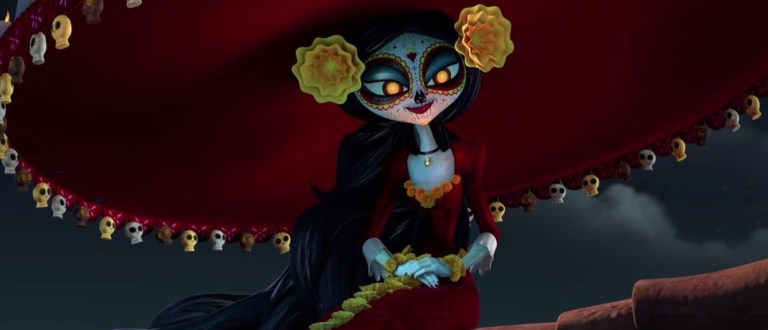
Inspired by the holiday The Day of the Dead, The Book of Life tells the story of a bullfighter named Manolo (Diego Luna) who journeys into the afterlife. One of the central characters is La Muerte (Kate del Castillo), the ruler of the Land of the Remembered. La Muerte is based on Santa Muerte, a deity and cult image originating in Mexico that often closely resembles the traditional look of the Grim Reaper.
Other Movies Referencing the Grim Reaper
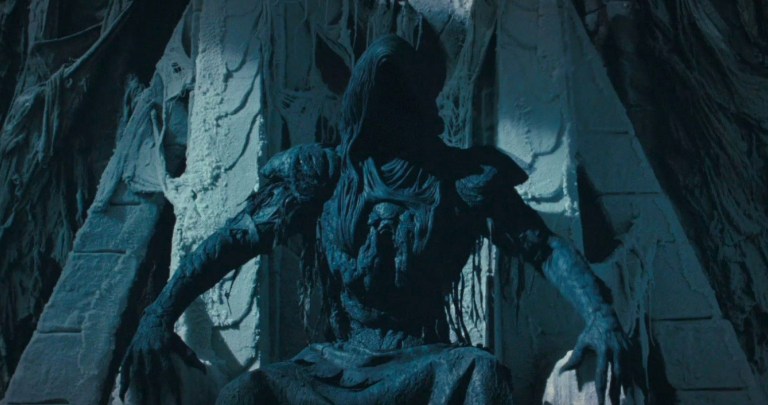
- Meshes of the Afternoon (1943) – A short film depicting Death in a black, hooded robe, but with a mirror in place of where its face would be.
- The Grim Reaper (1976) – This is a Christian exploitation movie (aka Christploitation) that tries to shock people into going to church with laughable visions of Hell. The Grim Reaper never seen, but he is mentioned by Jerry Falwell and used on the movie’s poster.
- Anthropophagus (1980) – This cannibal film from director Joe D’Amato is not about Death as a character, but it was released in various regions (including a censored USA release) with the title The Grim Reaper.
- Soultaker (1990) – B-movie star Robert Z’Dar is the Angel of Death who has his subordinate Soultakers (including Joe Estevez) help him usher the spirits of the dead into the afterlife via green glowing rings.
- Deconstructing Harry (1997) – This Woody Allen comedy features a brief scene where Tobey Maguire answers a knock at the door to find a foul-mouthed Grim Reaper standing there.
- Dead Like Me: Life After Death (2009) – Like the TV show it’s based on, this movie focuses on people who becomes “reapers” after they die.
- Solomon Kane (2009) – A demon referring to itself as the “Devil’s Reaper” sends Solomon Kane on a path of redemption after claiming Kane’s soul will be sent to Hell.
- Reaper (2014) – Danny Trejo, Vinnie Jones, and Jake Busey are featured in this low-budget horror movie about a supernatural entity called The Reaper who targets sinners for execution.
- Grim Reapers (2014) – Hooded figures with scythes terrorize a group of teens in an isolated house in this low-budget thriller.
- Butcher the Bakers (2017) – Two inept bakery-store employees are tasked with stopping a supernatural murderer who takes people’s souls in this odd low-budget horror comedy.
- Gerald’s Game (2017) – From Mike Flanagan, Carla Gugino stars as a woman left handcuffed to a bed when her husband dies. In her increasingly hallucinatory state, she sees a figure she believes may be Death coming to take her.
